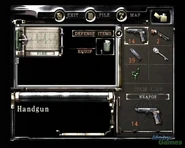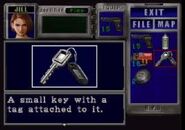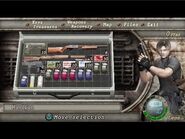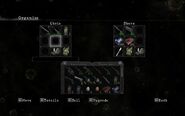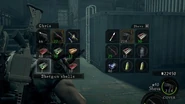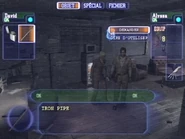| This article does not cite any sources. (March 2022) |
An inventory (status screen/sub-screen) is used in the Resident Evil series to store items. Starting in the first Resident Evil, the inventory, map, files, and condition (health) of the player character were shown in the status screen/sub-screen.
General[]
In most Resident Evil games key items, weapons, ammunition, and healing items are placed in single boxed spaces. Additional items could be placed inside an item box or security box. In Resident Evil 0 and the Outbreak titles items can simply be dropped. In Resident Evil 4, Resident Evil 5, and Resident Evil 6, items can be discarded completely to make room.
In many games, a character is given varying amounts of spaces to carry items. In Resident Evil 2 and CODE:Veronica, an item called the Side Pack is introduced which adds two additional spaces. This comes in handy as both of those games (as well as Zero) had items which took up two spaces such as the Hookshot, Spark Shot, Sub Machine Gun, Rocket Launcher, Gatling Gun, etc.
Certain characters often have an additional space for a personal item. This space is usually always filled and the item inside it cannot be moved or placed in the Item Box. Resident Evil 3: Nemesis did not have personal items while Code:Veronica and the Outbreak games did. Resident Evil 4 and games beyond have seemingly discontinued this trend.
Appearance[]
Resident Evil 0[]
In Resident Evil 0, Billy Coen and Rebecca Chambers are only given six spaces each, allowing for twelve spaces when they are together.
Resident Evil/REmake[]
In Resident Evil/REmake, Chris Redfield is only given six spaces while Jill Valentine is given eight.
REmake added another additional space strictly for Defense Items such as Daggers, Flash Grenades, and Battery Packs.
Resident Evil 2 (1998/2019)[]
In the original Resident Evil 2, Leon S. Kennedy, Claire Redfield, Ada Wong, and Sherry Birkin are given eight spaces. Leon and Claire can expand their inventories with the Side Pack.
In the remake, Leon/Claire starts off with eight spaces for items, however, a Hip Pouch can be used to grant two more spaces and given that players obtain every pouch can upgrade to 20 spaces in a playthrough. As with other RE Engine titles, the inventory is identical to that of Resident Evil 7, with the exception that the game pauses while inside the inventory screen. Bigger weapons, such as Sparkshot or Flamethrower, take up two spaces in the inventory. Some weapon take up two spaces when attached the appropriate upgrade part.
Similar to Resident Evil 5 and Resident Evil: Revelations 2, the player has the option to "hot-key" weapons to the certain keys on the control pad by equipping them to the "up", "down", "left" or "right" slots, however, weapons cannot be reloaded while in the inventory.
Resident Evil 3 (1999/2020)[]
Jill has eight spaces in the original Resident Evil 3: Nemesis, which are expand to ten when she gains a side pack at certain point. All three of the playable U.B.C.S. members have eight spaces too. Resident Evil 3: Nemesis did not have weapons that took up two spaces.
In the remake, Jill's and Carlos' initial inventory is eight spaces, but can be upgraded up to 20 spaces with Hip Pouches, much like in the RE2 remake. However, unlike the original RE3, bigger weapons like the MGL Grenade Launcher or the CQBR Assault Rifle require two spaces in the inventory.
Resident Evil: Dead Aim[]
Dead Aim offers a divided inventory that has different capacities for "Weapons", "Ammunition", and finally healing items and keys. The ammo section can only hold a limited space of 6 slots. The game offers handgun ammo as the most common type but allows the player to swap this ammo out if they find other kinds later. Weapons are few and far between in the game and therefore only take up as many slots as they need to. All healing items stack in their tray.
Resident Evil CODE: Veronica[]
In Code:Veronica, Claire starts off with eight and can increase it to ten. Chris now has eight and can also wear the side pack. In Battle Game, Steve Burnside and Albert Wesker have eight spaces.
Resident Evil Outbreak & Resident Evil Outbreak File #2[]
In the Outbreak titles, the inventory is real time and every character is given four spaces with the addition of a personal item, which, in a few cases, allow him/her to carry extra items. Yoko Suzuki, for example, has a knapsack that she can open to access four extra spaces. Cindy Lennox can also use her Herb Case to stock several Herbs and even mix them.
If players inventory is full when picking up an item, players can swap it with another unwanted item in their inventory as well as trading items with other ally characters.
Resident Evil 4[]
- Main article: Attache Case
Resident Evil 4 implemented a new inventory system which was remarkably different from previous games and seems to be the only game that have this system up to now. The player is given an Attache case which can be upgraded by the Merchant to hold more items. The Attache case takes the form of a grid, where items can be freely placed and turned to fit. Key items and treasures are no longer kept in the inventory but are held in a separate, unlimited, menu. Every item takes up a different amount of spaces on the grid, for example: Leon's Handgun takes up 2X3 spaces and can be turned to make it 3X2. Ammo, grenades, and healing items take up 1X2 spaces. Weapons take up varying amounts of spaces. Egg take only one space. The Tactical Vest does not take up any spaces.
Resident Evil: The Umbrella Chronicles[]
In The Umbrella Chronicles, the inventory system is changed to suit rail shooter approach. All handguns have infinite ammo and every other weapon has its ammo regenerated after each chapter. Ammo not spent is simply accumulated. Green Herbs are used immediately after they are picked up. First Aid Sprays are held until the player runs out of health and fully revives them afterwards. The inventory system allows for almost a dozen weapons to be held. Key items are not in the game.
Resident Evil 5[]
In Resident Evil 5, the inventory functions in real time. Both Chris and Sheva (as well as all other playable characters, such as those in Mercenaries or DLC modes) are given nine spaces in a 3x3 grid to hold items. No item takes up more than one space and partners can trade/swap items with few restrictions. Eggs and grenades now stack up to five per space. Herbs can still be combined but they are limited to only a mix of two. In this game, a Melee vest (which halves every melee damage) and Bulletproof vest (which halves every firearm-related damage) can be bought but each take up one space in the inventory.
When weapons or healing items are picked up during gameplay, they are automatically mapped to match the control pad, while ammo will first occupy the corners/center of the inventory. In this way, items can be "hot-keyed" without opening the inventory to select and equip them. For example, placing a handgun on the top center slot of the inventory will allow the player to draw it on the fly simply by pressing "up" on the control pad.
In the Item Management menu, items not currently equipped to a player's inventory are kept in a would-be "item box" that can be accessed between each chapter or before restarting from a checkpoint/dying. Treasures can only be viewed in the organize/item management screen. Key items are no longer kept in any kind of inventory and simply appear at the top left of the screen when acquired. These are shared between partners regardless of how far away they are from each other, nor does it matter which partner picked it up.
Resident Evil: Revelations[]
Resident Evil: Revelations doesn't feature an inventory screen. Players have to manage ammo, sub-weapons and healing items by looking at HUD. Up to three weapons can be equipped at any time, but key items have no limit to them. Ammo count can be upgraded by picking ammo cases throughout the game.
In Raid Mode, the player can upgrade their sub-weapon and First Aid Spray count by buying upgrades in the in-game store as they level up. Only three weapons are again the maximum that the player can carry.
Resident Evil 6[]
Resident Evil 6 again features a real-time inventory. There are two types of inventories, one designed for the quick switch of weapons or items, and a larger, main inventory for the player to see all of their items and combine them accordingly.
The quick access inventory is designed like a wheel, allowing the player to scroll quickly through their cache of weapons (by using "left" or "right") and healing items (by using "up" or "down").
The main inventory can also be used to equip weapons or items, though it is much slower doing this way. One useful thing from this mechanic can be used with the [Grenade Launcher, instead of having to switch between explosive, acid or nitrogen rounds in order, the player can just use the main inventory menu to switch to the desired ammo type in one go.
The main inventory is also designed so the player can quickly combine herbs without needing to select which to combine to, for example, if there are two green herbs and one red herb available, the game will automatically highlight the red herb as the next option when "combine" is selected on the green herb.
Resident Evil: The Darkside Chronicles[]
The inventory system in The Darkside Chronicles is somewhat different from the previous rail-shooter with elements of RE5's inventory. Weapons acquired in the game are permanently kept in a central inventory while the players can map three of the available weapons to "hot-key" them. Whenever the player chooses, they can access the central inventory to change weapons. Like in Umbrella Chronicles, the Handgun is a constant weapon with infinite ammunition, but ammo is not always replenished after chapters are completed and it is shared between players in co-op play. Herbs are not used on the spot as they were in Umbrella Chronicles and can be stacked. Like the weapons the herbs are mapped to a button (in this case the "+" button on the Wii Remote) and can be used whenever the player chooses. The First Aid Sprays are the same as they were previously; only used after one of the player characters loses all of their health.
Resident Evil: Revelations 2[]
Resident Evil: Revelations 2 introduce a different inventory from its predecessor, which has many elements of both classic and modern inventory screen. Players start with 10 slots for the main playable character (Claire and Barry) and 5 slots for the support characters (Moira and Natalia).
Health items, sub-weapons, and keys items take space in the inventory. Items can be combined to create bottles and healing items. Players can carry up to 4 weapons in a separated slot, if a new weapon is picked up when there are already four equipped in each slot, the equipped weapon will be replaced with the new one but it will remain available in the workbench.
To expand the inventory, players have to find ammo cases hideen in the game's environment. The main characters get maximum of 20 slots, and support characters get 15.
Resident Evil: The Deck Building Game[]
In Resident Evil: The Deck Building Game, the player's "Inventory" is essentially their deck. It is built during the game itself, as per the game's rules as a DBG. The default starting Inventory for all scenarios is 1 Handgun, 2 Knives, and 7 Ammo x10 cards. There are also unique custom inventories for each character which are primarily used for the game's Mercenaries and Versus mode.
Resident Evil 7: Biohazard[]
The inventory system in Resident Evil 7: Biohazard features as a combination of both Resident Evil 4's Attache Case and Resident Evil 5's Real-Time management. The player starts out with 12 inventory spaces which can be upgraded with backpacks lying around the environment, the first four spaces function as hot-keys to buttons on the control pad, but can only be used for knives, guns, and grenades. Some weapons such as handguns and knives take up one space while Magnums, Shotguns, Grenade Launchers, Machine Guns, and Flame Throwers take up two spaces. The player can also sometimes see their current health state via a codex watch when opening the inventory system. Item boxes in safe rooms make a return to help with the real time inventory management. Items found around the environment can also be combined to make either restoratives such as the First-Aid Med, various types of ammo for handguns, flame throwers, and grenade launchers, and Psycho-Stimulants to also help with cluttered inventory space.
Resident Evil Village[]
The inventory system in Resident Evil Village draws further inspiration from the Attache Case of Resident Evil 4, featuring a briefcase that also includes a health meter.
Gallery[]
| |||||||||||||||||||||||


